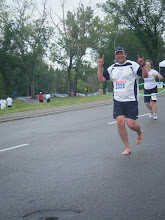Dear readers,
as an addendum to mile 4, I ran 5km barefoot today. I went full naked footed 2 weeks ago, have now ran over 10 miles bf and I feel great. I do get blisters though. My right foot had one on my big toe last week, but tonight I think I solved it’s issue, but at the expense of the lower outside center of my left foot. My feet seem to have the durability in the ankles, calves, overall strength etc… to run barefoot, I just gotta figure out the soul of my souls. I assume that is the feedback we so desire, and we will make changes to not get blisters.
I read a bunch of the beginner stuff on the Running Barefoot site, and the one thing that struck me was how you lift your toes, just ever so much before touching down to pre-tension the skin underneath so that the skin isn’t forced to stretch out under your weight once it’s on the ground. This should in theory eliminate the hot spots. I musta been concentrating on the right foot as it’s where the problem was last week. Now I can figure out the left!
I am considering the VFF’s. so I can run back to back days while bringing up my mileage and not rip the soles off my feet. Is that ok…? I won’t be thought of as a weenie will I?
signed,
curiously barefoot.

I mixed it up with vffs when starting out, but I'm not sure that was a good idea. If you stick with just being barefoot, you're less likely to do too much. It's possible that whatever inefficiency you have with your newbie form that is giving you blisters could give you bigger problems in vffs.
ReplyDeleteIf you do use minimalist footwear, try to run those miles on really rough, rocky terrain.
Here's a link that has a compilation of arguments against starting with vffs:
http://therunningbarefoot.com/?p=5575
but it doesn't apply directly to you really, since you're putting in a bunch of barefoot miles.
I'm pretty new at running barefoot -- total beginner. I just discovered -- on my 5th or 6th time out running a mile -- the slight toe lift thing. It seems like a pretty important missing (lost) piece of footwork in my life and once I became aware of it, I found I'm now starting using that facility of my foot while I'm wearing shoes too.
ReplyDeleteDon't worry. I already thought of you as a weenie.
ReplyDeleteHahahahaha! Just kidding.
Good luck finding what works for you.
Wow! No more comment moderation? What if I accidentally type "poo-poo"?
ReplyDeleteBF: I only thought about the VFFs so I can still run my longer distances, and take them off for the final x of the runs. Maybe I should just use my regular shoes? but i doan wanna use shoes!!!
ReplyDeleteAS: Yeah, the toe lift seems to make a HUGE difference. It also makes you 'lift' a the end of your stride.
Heisenberg: No swearing (runners don't swear anyway). I can still delete.
Well, the "right" answer is to not run the longer miles until you can do it barefoot. But if you did that, you would be one of the very few.
ReplyDeleteThink of it this way: it's a risk. How much of a risk depends on your pain acceptance, how quickly you learn, natural hardiness, and a bajillion other factors. So the risk is either negligible or you're screwed. Or somewhere in between. Like I said, the fact that you're putting in barefoot miles probably means you should be fine, just don't zone out.
Thanks dude. I feel really good, better than when i started shoe running, so that has to mean something. No zoning. I ain't that kinda guy. probably the opposite.
ReplyDeleteI sort of did the same thing except I have now opted for the Vibrams and run bf during training to enhance my stride. It is a weird balance as recently I have done all my shorter runs (6 miles or less) bf and my long runs in the Vibrams. The stride work does translate to the VFFs if you really focus but the VFFs do allow you to lose form if you don't pay close attention.
ReplyDeleteBut I would agree with BF Josh's comments and suggestions if you remain passionate about full transition to bf. Josh is a great resource.
Always remember, that in the end, you remain an experiment of one.